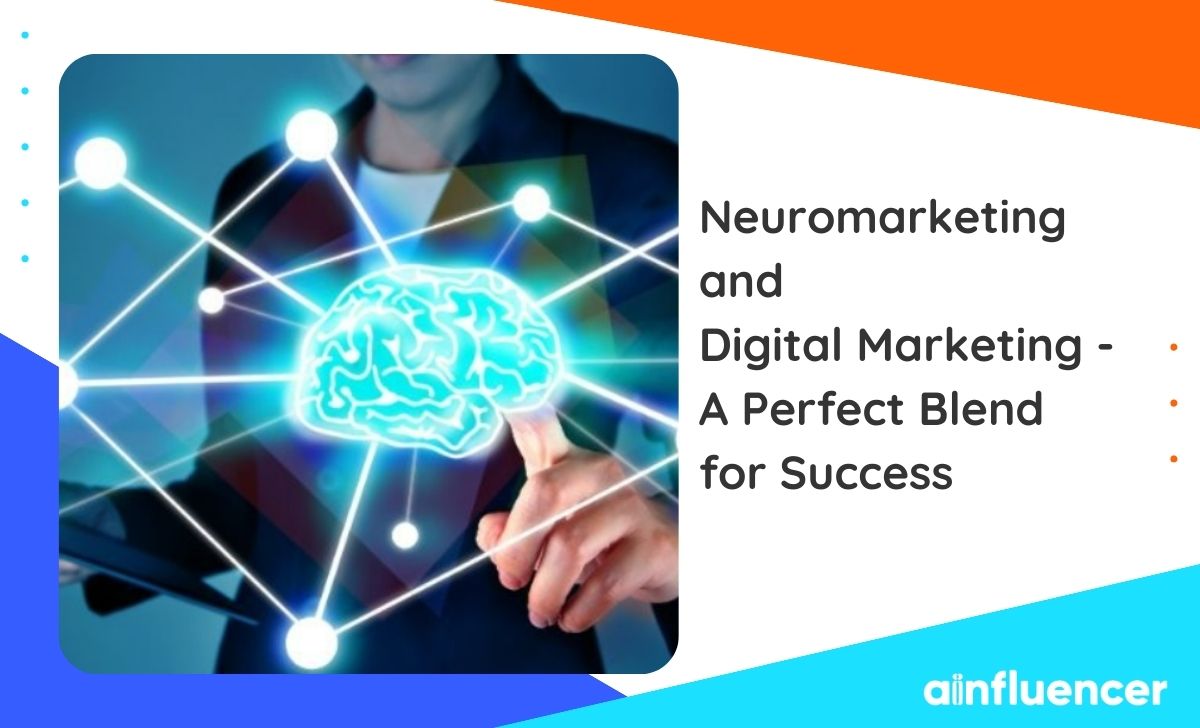Today’s businesses face tough competition. To stay ahead, they need to know how customers make decisions. Neuromarketing can help improve marketing, sales, and customer satisfaction in the digital space. By knowing more about consumer behavior, businesses can make better strategies to succeed.
Understanding Neuromarketing

Neuromarketing is a mix of neuroscience and marketing. It helps marketers know how consumers decide on things. By looking at brain activity and responses, we can learn what drives buying or engagement behaviors. Using this knowledge with tested marketing tactics, businesses can create powerful messages that connect with their target audience.
Digital marketing uses data and analytics. So, it works well with neuromarketing principles. These insights can make web design, content creation, social media advertising, and email campaigns better. Combining both fields creates a complete marketing approach that gets better results.
Neuromarketing Techniques in Digital Marketing

There are many neuromarketing techniques that can be used in digital marketing. Apart from the ones we’ve already mentioned on Ainfluencer, some other popular ones are:
1. Eye-tracking: This technique shows which parts of websites, emails, or ads get the most attention. It helps put important information or calls-to-action in the best spots.
For example, Casinowhizz.com attracts customers and increases conversions with eye-catching visuals and easy-to-use layouts.
2. Emotional triggers: Understanding emotions helps create content that makes people feel a certain way, such as happiness, fear, or curiosity.
Onlinecasinos2.com uses visuals, colors, and language that make people feel excited about online gambling. This engages visitors and makes them want to explore.
3. Cognitive biases: Digital marketers can use biases to increase conversions. The scarcity principle is one example. Showing limited-time offers or exclusive products makes people feel urgency and motivates them to act.
4. Social proof: Testimonials, ratings, and influencer endorsements make marketing messages more persuasive. Positive social proof can make your brand more credible and trustworthy.
5. Choice architecture: Designing layouts, visuals, and language can guide users to desired outcomes. Contrasting colors, descriptive language, and easy navigation can help.
6. Sensory marketing: Using sensory cues like visuals, sounds, and scents can create an immersive experience for users. This increases engagement and satisfaction.
Key Principles of Neuromarketing
1. Attention: Getting and keeping a user’s attention is important in digital marketing. Neuromarketing can help find visual elements, colors, and layouts that effectively draw attention and keep users engaged.
2. Emotion: Emotional connections are strong drivers of consumer behavior. Neuromarketing can help analyze emotional responses to digital marketing content, letting marketers create content that makes people feel the right emotions.
3. Memory: An important part of marketing is making sure consumers remember a brand or message. Neuromarketing gives insights into how the brain processes and stores memories, helping marketers make memorable content and experiences.
4. Decision-making: Neuromarketing looks at the thought processes that influence decision-making. Knowing these factors can help marketers design digital marketing campaigns that guide consumers to desired outcomes.
Applying Neuromarketing in Digital Marketing
Here are steps to use neuromarketing effectively in digital marketing:
1. Research: Know your target audience to find the best techniques for your campaign.
2. Test and iterate: Use neuromarketing strategies, analyze results, and make data-driven decisions. Use A/B testing to compare tactics and refine your approach based on performance.
3. Collaborate with experts: Work with neuromarketing professionals or researchers to access the latest knowledge and technologies. Expert insights can greatly improve your marketing strategy.
4. Learn continuously: Stay updated on neuromarketing research and explore new tactics. Education and innovation can help you stay ahead of industry trends and keep your competitive edge.
5. Prioritize ethics: Balance marketing success with ethical concerns. Avoid tactics that can harm customers or your brand’s image. Be transparent and respectful to your audience.
Benefits of Neuromarketing in Digital Marketing
By using neuromarketing techniques, digital marketers can enjoy several benefits, including:
1. Increased engagement: Understanding consumer preferences helps create content that makes users interact and engage more.
2. Improved conversion rates: Neuromarketing can help optimize calls-to-action, product offerings, and sales funnels, leading to higher conversion rates.
3. Better brand perception: By creating targeted campaigns that connect with users emotionally, businesses can create a more positive brand perception, building trust and loyalty.
4. Higher customer satisfaction: Neuromarketing helps you create personalized experiences tailored to your audience, which can result in increased satisfaction and retention.
5. More effective targeting: Knowing consumer behavior can help you find and target the right segments, reducing wasted ad spend and increasing return on investment (ROI).
6. Better data-driven decision-making: Neuromarketing insights can support data-driven decisions, making sure your marketing strategies are backed by scientific evidence and have a higher chance of success.
Challenges and Limitations of Neuromarketing in Digital Marketing
Despite its potential benefits, neuromarketing has some challenges and limitations. These include:
1. High costs: Neuromarketing research, especially techniques like fMRI and EEG, can be expensive. Smaller businesses might find it hard to invest in such technologies.
2. Ethical concerns: Neuromarketing can raise questions about consumer manipulation and privacy. Finding the right balance between ethical practices and marketing success is important.
3. Complex interpretation: Analyzing neuromarketing data needs expertise, as the results are not always simple. Wrong interpretation could lead to ineffective or counterproductive campaigns.
4. Rapid technological advancements: As technology and research methods in neuroscience change, businesses must adapt to stay competitive.
Future Trends in Neuromarketing and Digital Marketing
1. Advancements in technology: New developments in neuroscience, biometrics, and virtual reality can give deeper insights into consumer behavior and offer new opportunities for digital marketing.
2. Integration with artificial intelligence (AI): Using AI in neuromarketing can help find patterns, predict user behavior, and create personalized marketing experiences.
3. Rise of ethical marketing: Ethical marketing practices are becoming more important, as consumers demand transparency and responsible marketing.
4. Omnichannel experiences: Neuromarketing can help create smooth, personalized experiences across various digital channels, like websites, mobile apps, and social media platforms.
Accessibility and Inclusivity in Neuromarketing and Digital Marketing
1. Designing for diverse audiences: It’s important to create digital marketing content for all users, including those with disabilities or different cultural backgrounds. Neuromarketing can give insights on designing more accessible and inclusive digital experiences.
2. Ensuring usability: Neuromarketing can help find barriers to usability in digital marketing content and suggest improvements for a more user-friendly experience for everyone.
3. Language and communication: Neuromarketing insights can help create clearer, more effective messages that connect with a diverse audience.
4. Empathy in marketing: The role of empathy in digital marketing and how neuromarketing can help brands create more meaningful connections with their audience.
Practical Applications of Neuromarketing in Various Industries
1. eCommerce: Neuromarketing can improve online shopping by optimizing product pages, ad targeting, and checkout processes to increase sales and customer satisfaction.
2. Healthcare: Healthcare providers and organizations can use neuromarketing to create better health information campaigns, patient communication, and telehealth experiences.
3. Travel and hospitality: Neuromarketing can help travel and hospitality businesses create personalized booking experiences, targeted advertising, and engaging online content to drive bookings and customer loyalty.
4. Education: Educational institutions and e-learning platforms can use neuromarketing to create engaging content, user-friendly interfaces, and effective marketing campaigns to attract and keep students.
Challenges in Adopting Neuromarketing Across Different Cultures
1. Cultural differences in emotional responses: Emotions can vary across cultures, affecting how neuromarketing strategies connect with different audiences. It’s important to do research and collect data specific to each target market.
2. Language barriers: There are challenges in translating marketing messages that evoke emotions and appeal to cognitive biases across different languages. Work with language experts and conduct localized A/B tests to refine messaging.
3. Design and user experience preferences: Design preferences and user behavior can differ across cultures. Do user research and testing to adapt digital marketing strategies accordingly.
4. Legal and ethical considerations: Differences in regulations and cultural norms can affect how neuromarketing techniques are used. It’s important to understand local regulations and cultural expectations to ensure ethical and effective marketing practices.
The Role of Privacy in Neuromarketing and Digital Marketing
Privacy is critical in both neuromarketing and digital marketing. Since neuromarketing techniques often involve collecting and analyzing personal data—like behavioral patterns, emotional responses, and biometrics—businesses must follow data protection rules and respect user privacy. Failure to do so can lead to legal problems, damaged reputations, and loss of consumer trust.
To address privacy concerns, businesses should:
1. Be transparent: Clearly explain how user data is collected, stored, and used in marketing campaigns. Give users the information they need to make informed decisions about sharing their personal information.
2. Obtain consent: Get clear consent from users before collecting and processing their data. Make sure users can revoke consent and ask for their data to be deleted or changed.
3. Maintain data security: Use strong data security measures to protect users’ personal information from unauthorized access, breaches, or theft.
4. Comply with regulations: Know and follow data protection rules, like the General Data Protection Regulation (GDPR) and the California Consumer Privacy Act (CCPA). Regularly review and update privacy policies and practices to stay current with changing regulations.
Neuromarketing and Digital Marketing Ethics
While neuromarketing offers valuable insights into consumer behavior, ethical concerns may arise about potential manipulation and exploitation of users. Finding the right balance between effective marketing strategies and responsible practices is key to keeping consumer trust and brand credibility.
To ensure ethical neuromarketing practices, businesses should:
1. Avoid manipulation: Don’t use neuromarketing insights to exploit users’ weaknesses or deceive them into making decisions not in their best interests.
2. Encourage informed decision-making: Use neuromarketing techniques to help users make informed choices rather than limiting their options or manipulating their preferences.
3. Promote transparency: Be open about using neuromarketing techniques in digital marketing campaigns and explain the purpose and benefits to users.
4. Foster a culture of ethical marketing: Set internal guidelines and have regular discussions within the organization to make sure marketing practices match ethical standards and consumer needs.
By following these guidelines and balancing marketing success with ethical concerns, businesses can create positive, trustworthy relationships with their audience and achieve lasting success in the digital marketing landscape.
Conclusion
In the fast-paced digital marketing world, neuromarketing offers valuable insights into understanding customer thoughts and emotions. Using these techniques can help create impactful campaigns that resonate with the audience. By combining science and creativity, businesses can stay ahead of the competition and maintain a strong connection with their target audience.
While challenges and limitations do exist, the benefits of adopting neuromarketing strategies in digital marketing can outweigh the drawbacks. Success lies in adopting a balanced approach that prioritizes ethical considerations and focuses on continuous learning and adaptation. By doing so, businesses can unlock the full potential of neuromarketing to drive growth and enhance customer relationships.









